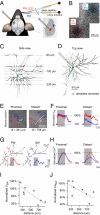Dendritic coding of multiple sensory inputs in single cortical neurons in vivo
- PMID: 21876170
- PMCID: PMC3174623
- DOI: 10.1073/pnas.1112355108
Dendritic coding of multiple sensory inputs in single cortical neurons in vivo
Abstract
Single cortical neurons in the mammalian brain receive signals arising from multiple sensory input channels. Dendritic integration of these afferent signals is critical in determining the amplitude and time course of the neurons' output signals. As of yet, little is known about the spatial and temporal organization of converging sensory inputs. Here, we combined in vivo two-photon imaging with whole-cell recordings in layer 2 neurons of the mouse vibrissal cortex as a means to analyze the spatial pattern of subthreshold dendritic calcium signals evoked by the stimulation of different whiskers. We show that the principle whisker and the surrounding whiskers can evoke dendritic calcium transients in the same neuron. Distance-dependent attenuation of dendritic calcium transients and the corresponding subthreshold depolarization suggest feed-forward activation. We found that stimulation of different whiskers produced multiple calcium hotspots on the same dendrite. Individual hotspots were activated with low probability in a stochastic manner. We show that these hotspots are generated by calcium signals arising in dendritic spines. Some spines were activated uniquely by single whiskers, but many spines were activated by multiple whiskers. These shared spines indicate the existence of presynaptic feeder neurons that integrate and transmit activity arising from multiple whiskers. Despite the dendritic overlap of whisker-specific and shared inputs, different whiskers are represented by a unique set of activation patterns within the dendritic field of each neuron.
Conflict of interest statement
The authors declare no conflict of interest.
Figures




Similar articles
-
Functional mapping of single spines in cortical neurons in vivo.Nature. 2011 Jun 26;475(7357):501-5. doi: 10.1038/nature10193. Nature. 2011. PMID: 21706031
-
Intrinsic firing patterns and whisker-evoked synaptic responses of neurons in the rat barrel cortex.J Neurophysiol. 1999 Mar;81(3):1171-83. doi: 10.1152/jn.1999.81.3.1171. J Neurophysiol. 1999. PMID: 10085344
-
Nonlinear dendritic integration of sensory and motor input during an active sensing task.Nature. 2012 Dec 13;492(7428):247-51. doi: 10.1038/nature11601. Epub 2012 Nov 11. Nature. 2012. PMID: 23143335
-
Intracortical processes regulating the integration of sensory information.Prog Brain Res. 1990;86:129-41. doi: 10.1016/s0079-6123(08)63172-6. Prog Brain Res. 1990. PMID: 1982365 Review.
-
Experience-dependent changes in function and anatomy of adult barrel cortex.Exp Brain Res. 1998 Nov;123(1-2):110-6. doi: 10.1007/s002210050551. Exp Brain Res. 1998. PMID: 9835399 Review.
Cited by
-
Transformation of primary sensory cortical representations from layer 4 to layer 2.Nat Commun. 2022 Sep 19;13(1):5484. doi: 10.1038/s41467-022-33249-1. Nat Commun. 2022. PMID: 36123376 Free PMC article.
-
Mean-field analysis of orientation selectivity in inhibition-dominated networks of spiking neurons.Springerplus. 2014 Mar 19;3:148. doi: 10.1186/2193-1801-3-148. eCollection 2014. Springerplus. 2014. PMID: 24790806 Free PMC article.
-
Differential processing in modality-specific Mauthner cell dendrites.J Physiol. 2018 Feb 15;596(4):667-689. doi: 10.1113/JP274861. Epub 2017 Dec 18. J Physiol. 2018. PMID: 29148564 Free PMC article.
-
Astrocyte coverage of excitatory synapses correlates to measures of synapse structure and function in ferret primary visual cortex.Glia. 2024 Oct;72(10):1785-1800. doi: 10.1002/glia.24582. Epub 2024 Jun 10. Glia. 2024. PMID: 38856149
-
Intravital imaging of dendritic spine plasticity.Intravital. 2015 Jan 6;3(3):e944439. doi: 10.4161/21659087.2014.984504. eCollection 2014 Dec. Intravital. 2015. PMID: 28243511 Free PMC article.
References
-
- Cajal SRY. Histology of the Nervous System of Man and Vertebrates. London: Oxford University Press; 1994.
-
- DeFalco J, et al. Virus-assisted mapping of neural inputs to a feeding center in the hypothalamus. Science. 2001;291:2608–2613. - PubMed
MeSH terms
Substances
LinkOut - more resources
Full Text Sources
Research Materials

